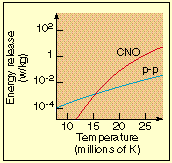The proton—proton chain is not the only nuclear process operating in the Sun and other late-generation stars. Another fusion mechanism capable of converting hydrogen into helium, starting from carbon-12 (12C), proceeds according to the following six steps. Nitrogen (N) and oxygen (O) nuclei are created as intermediate products:
These six steps are termed the CNO cycle. Aside from the radiation and neutrinos produced, notice that the sum total of these six reactions is 12C + 4(1H) In other words, the net result is the fusion of four protons into a single helium-4 nucleus, just as in the proton—proton chain. The carbon-12 acts merely as a catalyst, an agent of change that is not itself consumed in the reaction. The electromagnetic forces of repulsion operating in the CNO cycle are greater than in the proton—proton chain because the charges of the heavy-element nuclei are larger. Accordingly, higher temperatures are required to propel the heavy nuclei into the realm of the strong nuclear force and to ignite fusion. The accompanying figure presents a numerical estimate of the energy released in the Sun by the proton—proton chain and the CNO cycle, each as a function of gas temperature. The proton—proton chain dominates at lower temperatures, up to about 16 million K. Above this temperature, the CNO cycle is the more important fusion process in stars of solar composition. According to our theoretical models of the Sun, the temperature of the solar core is 15 million K, so these curves indicate that the proton—proton cycle is the dominant source of solar energy (notice that each step on the vertical scale corresponds to a factor of 100 in energy generation). The CNO cycle contributes no more than 10 percent of the observed solar radiation. However, stars more massive than our Sun often have core temperatures much higher than 20 million K, making the CNO cycle the dominant energy-production mechanism. |
